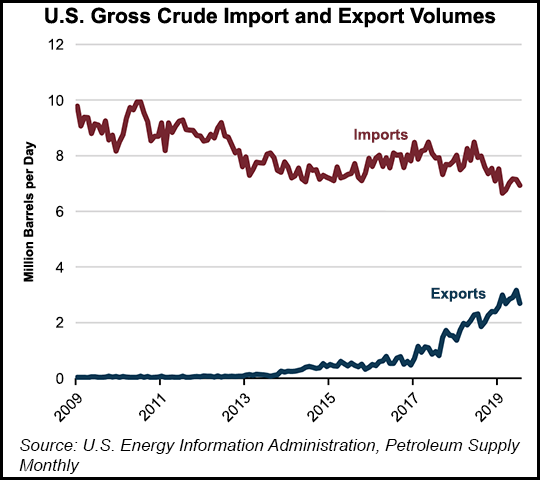U.S. Crude Export Destinations Now Outnumbering Import Sources, EIA Says
As exports of U.S. crude oil have continued to ramp up in 2019, the number of export destinations for domestically produced crude now exceeds the number of places supplying imports into the United States, according to the Energy Information Administration (EIA).

U.S. crude exports have increased to an average 2.8 million b/d through the first seven months of this year, continuing an upward trajectory in export volumes catalyzed when Congress lifted a longstanding ban in late 2015. In 2009, the United States imported crude from as many as 37 sources in a given month, whereas in 2019 the maximum number of monthly import sources fell to 27, according to EIA.
The decline in the number of oil importers to the United States has coincided with an increase in the number of export destinations, a category that includes countries, territories, autonomous regions and other administrative regions, EIA said. From January through June, the United States exported to as many as 31 destinations per month.
Before Congress lifted the export ban, U.S. crude exports went “almost exclusively” to Canada.
“Between January 2016 (the first full month of unrestricted U.S. crude oil exports) and July 2019, U.S. crude oil production increased by 2.6 million b/d, and export volumes increased by 2.2 million b/d,” EIA said.

The increase in domestic production has driven down the number of import sources for the United States. Most of the increase in domestic production has been “relatively light-sweet crude oil, but most U.S. refineries are configured to process medium- to heavy-sour crude oil,” EIA said.
“U.S. refineries have accommodated this increase in production by displacing imports of light and medium crude oils from countries other than Canada and by increasing refinery utilization rates.”
Meanwhile, demand for light-sweet crude has increased abroad, and infrastructure changes, including increased pipeline capacity to export terminals, have allowed more exports from the United States. Export terminals have also been expanded to allow for more crude tanker traffic, larger tankers and larger cargo sizes, according to EIA.
“More stringent national and international regulations limiting the sulfur content of transportation fuels are also affecting demand for light-sweet crude oil,” EIA said. “Many of the less complex refineries outside of the United States cannot process and remove sulfur from heavy-sour crude oils and are better suited to process light-sweet crude oil into transportation fuels with lower sulfur content.”
© 2024 Natural Gas Intelligence. All rights reserved.
ISSN © 2577-9877 | ISSN © 2158-8023 |
